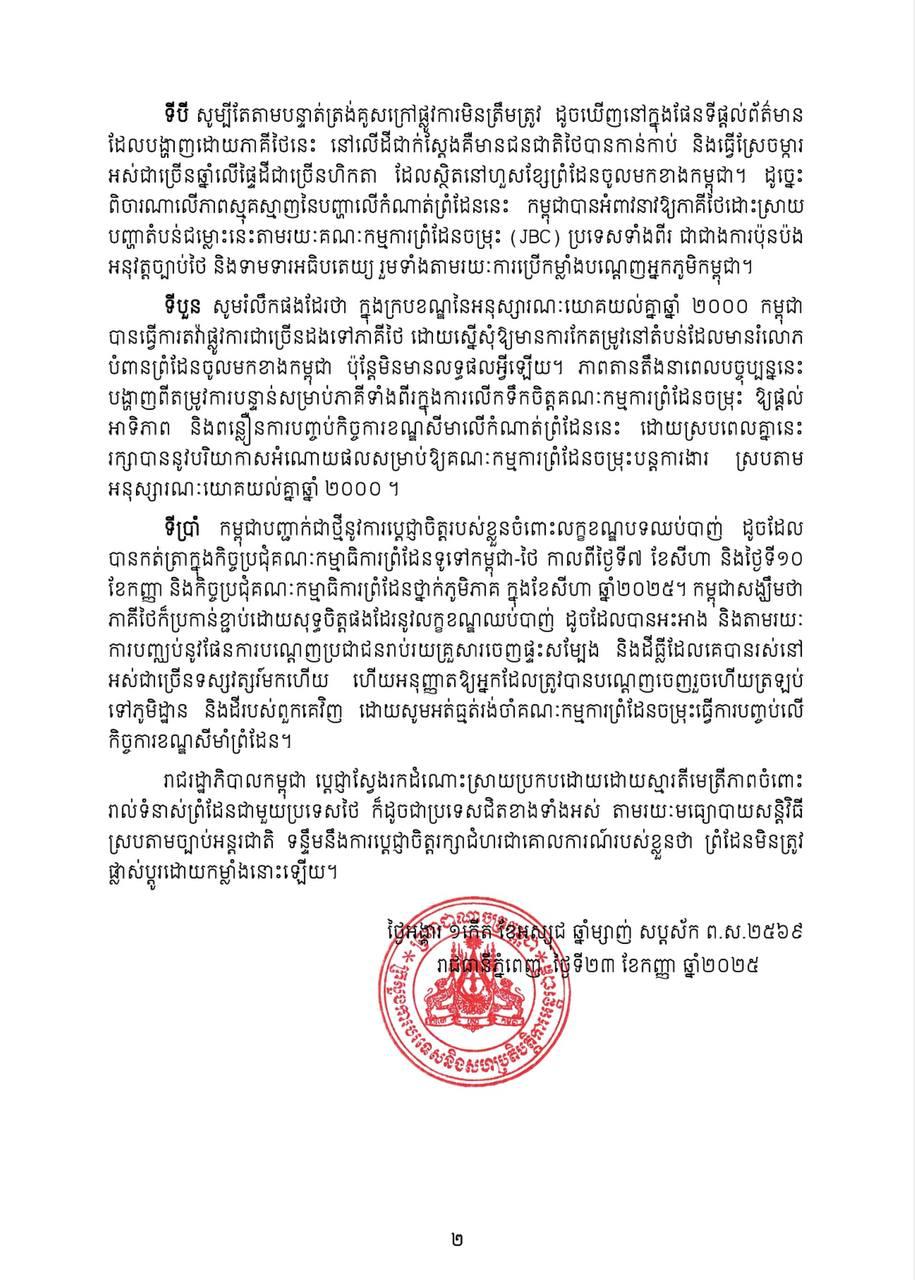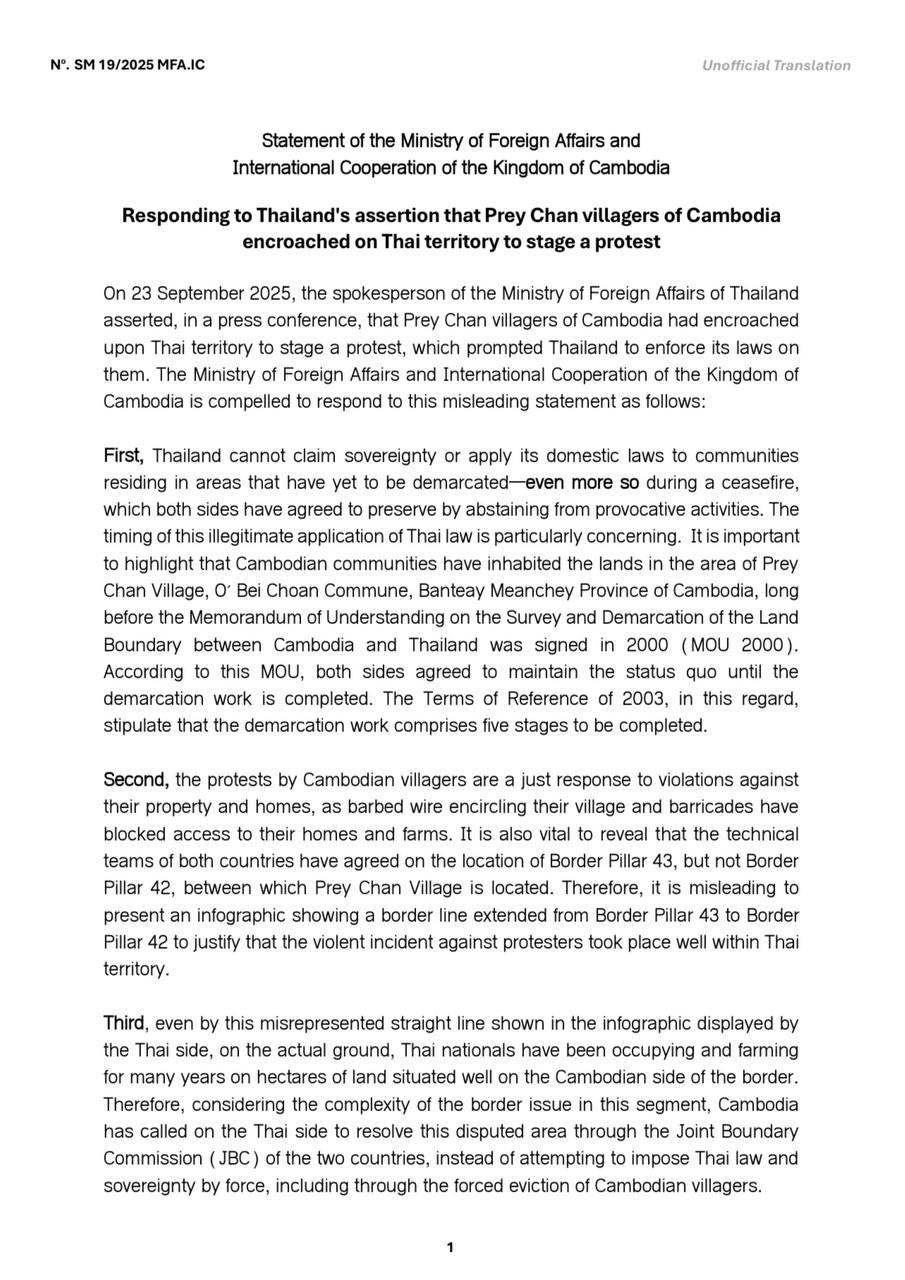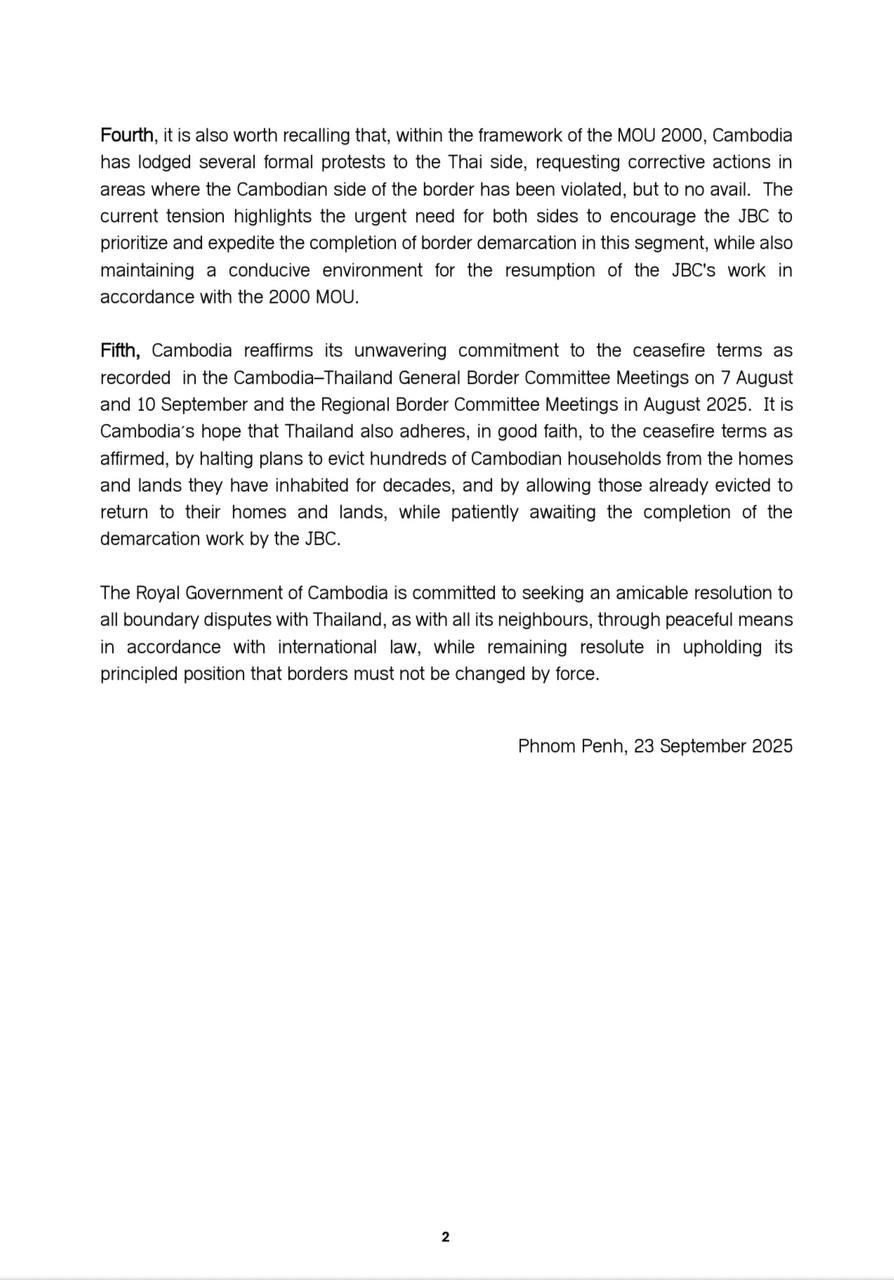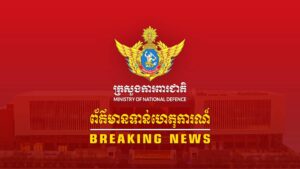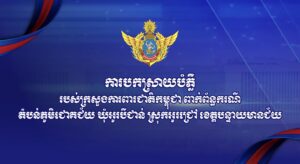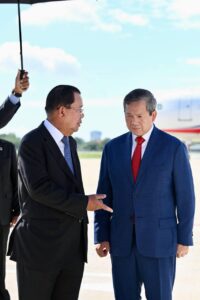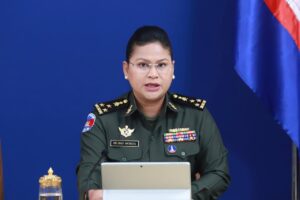កម្ពុជាបដិសេធការអះអាងរបស់ថៃជុំវិញការតវ៉ានៅភូមិព្រៃចាន់ និងទាមទារឲ្យមានដំណោះស្រាយដោយសន្តិវិធីតាមរយៈ JBC (English Below)
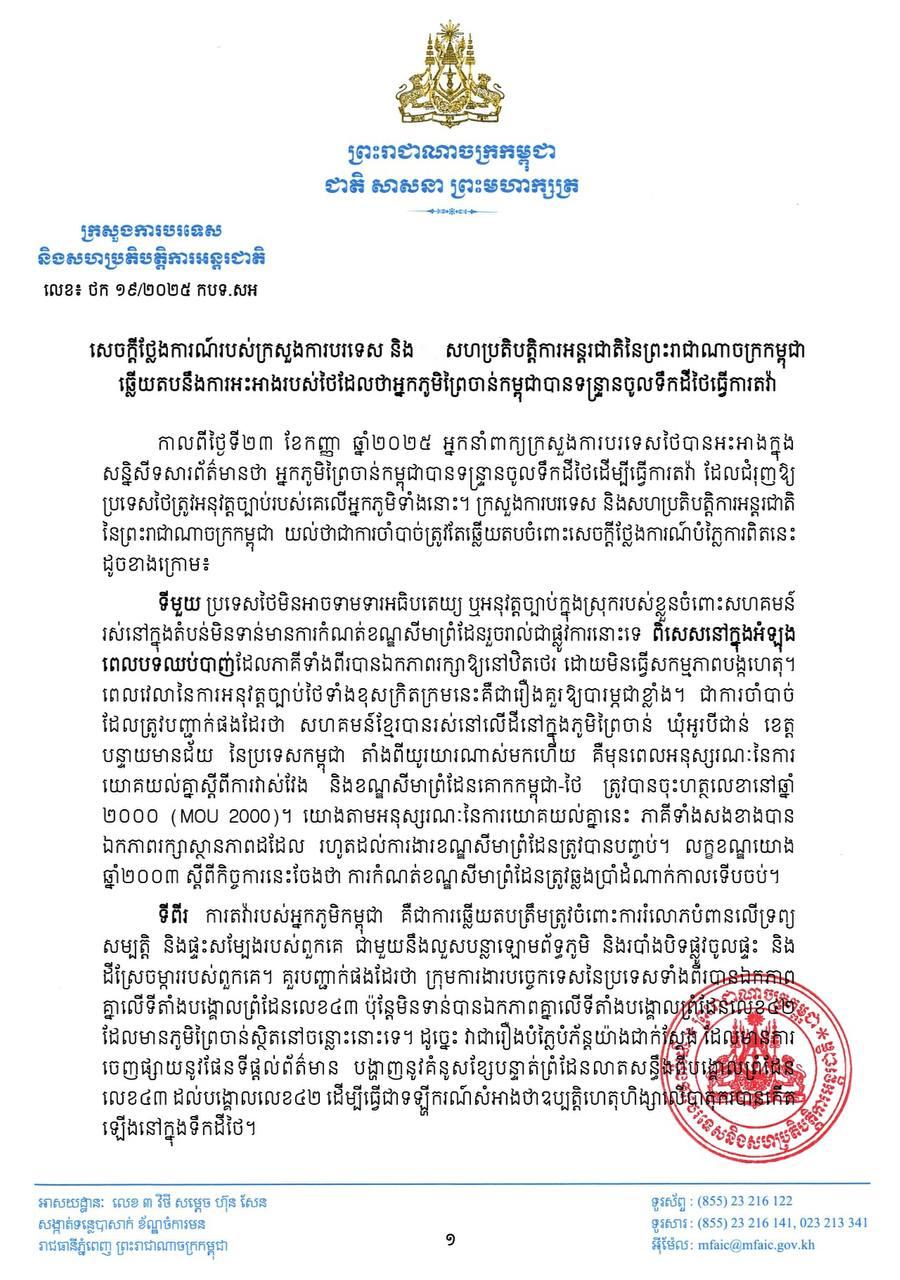 កម្ពុជាបដិសេធការអះអាងរបស់ថៃជុំវិញការតវ៉ានៅភូមិព្រៃចាន់ និងទាមទារឲ្យមានដំណោះស្រាយដោយសន្តិវិធីតាមរយៈ JBC (English Below)
កម្ពុជាបដិសេធការអះអាងរបស់ថៃជុំវិញការតវ៉ានៅភូមិព្រៃចាន់ និងទាមទារឲ្យមានដំណោះស្រាយដោយសន្តិវិធីតាមរយៈ JBC (English Below)
នាព្រឹកថ្ងៃទី២៤ ខែកញ្ញា ឆ្នាំ២០២៥ នេះ ក្រសួងការបរទេស និងសហប្រតិបត្តិការអន្តរជាតិ នៃព្រះរាជាណាចក្រកម្ពុជា បានច្រានចោលយ៉ាងដាច់អហង្ការចំពោះការអះអាងរបស់ថៃ ដែលថាអ្នកភូមិព្រៃចាន់កម្ពុជាបានទន្ទ្រានចូលទឹកដីថៃដើម្បីធ្វើការតវ៉ា។
ថ្លែងនៅក្នុងសន្និសីទសារព័ត៌មានកាលពីថ្ងៃទី២៣ ខែកញ្ញា ឆ្នាំ២០២៥ អ្នកនាំពាក្យក្រសួងការបរទេសថៃបានអះអាងថា អ្នកភូមិព្រៃចាន់របស់កម្ពុជាបានឆ្លងចូលទឹកដីថៃ ដែលជំរុញឱ្យ ប្រទេសថៃត្រូវអនុវត្តច្បាប់របស់គេលើអ្នកភូមិទាំងនោះ។
ក្រសួងការបរទេស និងសហប្រតិបត្តិការអន្តរជាតិ នៃព្រះរាជាណាចក្រកម្ពុជា យល់ថា នេះជាការចាំបាច់ដែលត្រូវតែឆ្លើយតបចំពោះសេចក្ដីថ្លែងការណ៍បំភ្លៃការពិតនោះ ដូចខាងក្រោម៖
ទីមួយ៖ ប្រទេសថៃមិនអាចទាមទារអធិបតេយ្យ ឬអនុវត្តច្បាប់ក្នុងស្រុករបស់ខ្លួនចំពោះសហគមន៍ រស់នៅក្នុងតំបន់មិនទាន់មានការកំណត់ខណ្ឌសីមាព្រំដែនរួចរាល់ជាផ្លូវការនោះទេ ពិសេសនៅក្នុងអំឡុង ពេលបទឈប់បាញ់ដែលភាគីទាំងពីរបានឯកភាពរក្សាឱ្យនៅឋិតថេរ ដោយមិនធ្វើសកម្មភាពបង្កហេតុ។ ពេលវេលានៃការអនុវត្តច្បាប់ថៃទាំងខុសក្រិតក្រមនេះគឺជារឿងគួរឱ្យបារម្ភជាខ្លាំង។ ជាការចាំបាច់ ដែលត្រូវបញ្ជាក់ផងដែរថា សហគមន៍ខ្មែរបានរស់នៅលើដីនៅក្នុងភូមិព្រៃចាន់ ឃុំអូរបីជាន់ ខេត្ត បន្ទាយមានជ័យ នៃប្រទេសកម្ពុជា តាំងពីយូរយារណាស់មកហើយ គឺមុនពេលអនុស្សរណៈនៃការ យោគយល់គ្នាស្តីពីការវាស់វែង និងខណ្ឌសីមាព្រំដែនគោកកម្ពុជា-ថៃ ត្រូវបានចុះហត្ថលេខានៅឆ្នាំ ២០០០ (MOU 2000)។ យោងតាមអនុស្សរណៈនៃការយោគយល់គ្នានេះ ភាគីទាំងសងខាងបាន ឯកភាពរក្សាស្ថានភាពដដែល រហូតដល់ការងារខណ្ឌសីមាព្រំដែនត្រូវបានបញ្ចប់។ លក្ខខណ្ឌយោង ឆ្នាំ២០០៣ ស្ដីពីកិច្ចការនេះចែងថា ការកំណត់ខណ្ឌសីមាព្រំដែនត្រូវឆ្លងប្រាំដំណាក់កាលទើបចប់។
ទីពីរ៖ ការតវ៉ារបស់អ្នកភូមិកម្ពុជា គឺជាការឆ្លើយតបត្រឹមត្រូវចំពោះការរំលោភបំពានលើទ្រព្យ សម្បត្តិ និងផ្ទះសម្បែងរបស់ពួកគេ ជាមួយនឹងលួសបន្លាឡោមព័ទ្ធភូមិ និងរបាំងបិទផ្លូវចូលផ្ទះ និង ដីស្រែចម្ការរបស់ពួកគេ។ គួរបញ្ជាក់ផងដែរថា ក្រុមការងារបច្ចេកទេសនៃប្រទេសទាំងពីរបានឯកភាព
គ្នាលើទីតាំងបង្គោលព្រំដែនលេខ៤៣ ប៉ុន្តែមិនទាន់បានឯកភាពគ្នាលើទីតាំងបង្គោលព្រំដែនលេខ៤២
ដែលមានភូមិព្រៃចាន់ស្ថិតនៅចន្លោះនោះទេ។ ដូច្នេះ វាជារឿងបំភ្លៃបំភ័ន្តយ៉ាងជាក់ស្ដែង ដែលមានការ ចេញផ្សាយនូវផែនទីផ្តល់ព័ត៌មាន បង្ហាញនូវគំនូសខ្សែបន្ទាត់ព្រំដែនលាតសន្ធឹងពីបង្គោលព្រំដែន លេខ៤៣ ដល់បង្គោលលេខ៤២ ដើម្បីធ្វើជាទឡីករណ៍សំអាងថាឧប្បត្តិហេតុហិង្សាលើបាតុករបានកើតឡើងនៅក្នុងទឹកដីថៃ។
ទីបី៖ សូម្បីតែតាមបន្ទាត់ត្រង់គូសក្រៅផ្លូវការមិនត្រឹមត្រូវ ដូចឃើញនៅក្នុងផែនទីផ្ដល់ព័ត៌មាន ដែលបង្ហាញដោយភាគីថៃនេះ នៅលើដីជាក់ស្ដែងគឺមានជនជាតិថៃបានកាន់កាប់ និងធ្វើស្រែចម្ការ អស់ជាច្រើនឆ្នាំលើផ្ទៃដីជាច្រើនហិកតា ដែលស្ថិតនៅហួសខ្សែព្រំដែនចូលមកខាងកម្ពុជា។ ដូច្នេះ ពិចារណាលើភាពស្មុគស្មាញនៃបញ្ហាលើកំណាត់ព្រំដែននេះ កម្ពុជាបានអំពាវនាវឱ្យភាគីថៃដោះស្រាយ បញ្ហាតំបន់ជម្លោះនេះតាមរយៈគណៈកម្មការព្រំដែនចម្រុះ (JBC) ប្រទេសទាំងពីរ ជាជាងការប៉ុនប៉ង អនុវត្តច្បាប់ថៃ និងទាមទារអធិបតេយ្យ រួមទាំងតាមរយៈការប្រើកម្លាំងបណ្ដេញអ្នកភូមិកម្ពុជា។
ទីបួន៖ សូមរំលឹកផងដែរថា ក្នុងក្របខណ្ឌនៃអនុស្សារណៈយោគយល់គ្នាឆ្នាំ ២០០០ កម្ពុជា បានធ្វើការតវ៉ាផ្លូវការជាច្រើនដងទៅភាគីថៃ ដោយស្នើសុំឱ្យមានការកែតម្រូវនៅតំបន់ដែលមានរំលោភ បំពានព្រំដែនចូលមកខាងកម្ពុជា ប៉ុន្តែមិនមានលទ្ធផលអ្វីឡើយ។ ភាពតានតឹងនាពេលបច្ចុប្បន្ននេះ បង្ហាញពីតម្រូវការបន្ទាន់សម្រាប់ភាគីទាំងពីរក្នុងការលើកទឹកចិត្តគណៈកម្មការព្រំដែនចម្រុះ ឱ្យផ្ដល់ អាទិភាព និងពន្លឿនការបញ្ចប់កិច្ចការខណ្ឌសីមាលើកំណាត់ព្រំដែននេះ ដោយស្របពេលគ្នានេះ រក្សាបាននូវបរិយាកាសអំណោយផលសម្រាប់ឱ្យគណៈកម្មការព្រំដែនចម្រុះបន្តការងារ ស្របតាម អនុស្សារណៈយោគយល់គ្នាឆ្នាំ ២០០០ ។
ទីប្រាំ៖ កម្ពុជាបញ្ជាក់ជាថ្មីនូវការប្ដេជ្ញាចិត្តរបស់ខ្លួនចំពោះលក្ខខណ្ឌបទឈប់បាញ់ ដូចដែល បានកត់ត្រាក្នុងកិច្ចប្រជុំគណៈកម្មាធិការព្រំដែនទូទៅកម្ពុជា-ថៃ កាលពីថ្ងៃទី៧ ខែសីហា និងថ្ងៃទី១០ ខែកញ្ញា និងកិច្ចប្រជុំគណៈកម្មាធិការព្រំដែនថ្នាក់ភូមិភាគ ក្នុងខែសីហា ឆ្នាំ២០២៥។ កម្ពុជាសង្ឃឹមថា ភាគីថៃក៏ប្រកាន់ខ្ជាប់ដោយសុទ្ធចិត្តផងដែរនូវលក្ខខណ្ឌឈប់បាញ់ ដូចដែលបានអះអាង និងតាមរយៈ ការបញ្ឈប់នូវផែនការបណ្ដេញប្រជាជនរាប់រយគ្រួសារចេញផ្ទះសម្បែង និងដីធ្លីដែលគេបានរស់នៅ
អស់ជាច្រើនទស្សវត្សរ៍មកហើយ ហើយអនុញ្ញាតឱ្យអ្នកដែលត្រូវបានបណ្ដេញចេញរួចហើយត្រឡប់ ទៅភូមិដ្ឋាន និងដីរបស់ពួកគេវិញ ដោយសូមអត់ធ្មត់រង់ចាំគណៈកម្មការព្រំដែនចម្រុះធ្វើការបញ្ចប់លើ កិច្ចការខណ្ឌសីមាំព្រំដែន។
សេចក្តីថ្លែងការណ៍ដដែលបានសង្កត់ធ្ងន់ថា រាជរដ្ឋាភិបាលកម្ពុជានៅតែប្តេជ្ញាដោះស្រាយរាល់ជម្លោះព្រំដែនជាមួយប្រទេសថៃក៏ដូចជាប្រទេសជិតខាងទាំងអស់ដោយសន្តិវិធីនិងស្របតាមច្បាប់អន្តរជាតិ និងបញ្ជាក់ថា «ព្រំដែនមិនត្រូវផ្លាស់ប្តូរដោយបង្ខំឡើយ»៕
On 23 September 2025, the spokesperson of the Ministry of Foreign Affairs of Thailand asserted, in a press conference, that Prey Chan villagers of Cambodia had encroached upon Thai territory to stage a protest, which prompted Thailand to enforce its laws on them. The Ministry of Foreign Affairs and International Cooperation of the Kingdom of Cambodia is compelled to respond to this misleading statement as follows:
First, Thailand cannot claim sovereignty or apply its domestic laws to communities residing in areas that have yet to be demarcated-even more so during a ceasefire, which both sides have agreed to preserve by abstaining from provocative activities. The timing of this illegitimate application of Thai law is particularly concerning. It is important to highlight that Cambodian communities have inhabited the lands in the area of Prey Chan Village, O’ Bei Choan Commune, Banteay Meanchey Province of Cambodia, long before the Memorandum of Understanding on the Survey and Demarcation of the Land Boundary between Cambodia and Thailand was signed in 2000 (MOU 2000). According to this MOU, both sides agreed to maintain the status quo until the demarcation work is completed. The Terms of Reference of 2003, in this regard, stipulate that the demarcation work comprises five stages to be completed.
Second, the protests by Cambodian villagers are a just response to violations against their property and homes, as barbed wire encircling their village and barricades have blocked access to their homes and farms. It is also vital to reveal that the technical teams of both countries have agreed on the location of Border Pillar 43, but not Border Pillar 42, between which Prey Chan Village is located. Therefore, it is misleading to present an infographic showing a border line extended from Border Pillar 43 to Border Pillar 42 to justify that the violent incident against protesters took place well within Thai territory.
Third, even by this misrepresented straight line shown in the infographic displayed by the Thai side, on the actual ground, Thai nationals have been occupying and farming for many years on hectares of land situated well on the Cambodian side of the border. Therefore, considering the complexity of the border issue in this segment, Cambodia has called on the Thai side to resolve this disputed area through the Joint Boundary Commission (JBC) of the two countries, instead of attempting to impose Thai law and sovereignty by force, including through the forced eviction of Cambodian villagers.
Fourth, it is also worth recalling that, within the framework of the MOU 2000, Cambodia has lodged several formal protests to the Thai side, requesting corrective actions in areas where the Cambodian side of the border has been violated, but to no avail. The current tension highlights the urgent need for both sides to encourage the JBC to prioritize and expedite the completion of border demarcation in this segment, while also maintaining a conducive environment for the resumption of the JBC’s work in accordance with the 2000 MOU.
Fifth, Cambodia reaffirms its unwavering commitment to the ceasefire terms as recorded in the Cambodia-Thailand General Border Committee Meetings on 7 August and 10 September and the Regional Border Committee Meetings in August 2025. It is Cambodia’s hope that Thailand also adheres, in good faith, to the ceasefire terms as affirmed, by halting plans to evict hundreds of Cambodian households from the homes and lands they have inhabited for decades, and by allowing those already evicted to return to their homes and lands, while patiently awaiting the completion of the demarcation work by the JBC.
The Royal Government of Cambodia is committed to seeking an amicable resolution to all boundary disputes with Thailand, as with all its neighbours, through peaceful means in accordance with international law, while remaining resolute in upholding its principled position that borders must not be changed by force.

